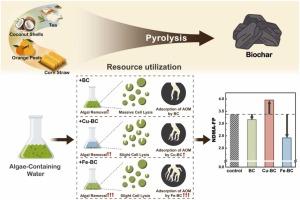生物炭在藻类源水处理中的作用:藻类细胞的完整性和 N-亚硝基二甲胺 (NDMA) 形成的可能性
IF 11.3
1区 环境科学与生态学
Q1 ENGINEERING, ENVIRONMENTAL
引用次数: 0
摘要
研究了茶叶(TBC)、椰子壳(NBC)、玉米秸秆(SBC)和橘子皮(OBC)制备的未改性和改性生物炭(BC)对含藻水体中藻类去除效率和NDMA生成势(NDMA- fp)的影响。未经改性的BC提高了藻类去除率(12% ~ 45%)和NDMA- fp降低率(1% ~ 20%),表明BC在脱除藻类和NDMA形成风险控制中的潜在应用。Cu(Ⅰ/Ⅱ)-改性BC (Cu(Ⅰ/Ⅱ)-BC)显著提高了除藻效率(可达80%),其中对铜绿微囊藻的物理膜损伤最为显著(85-99%),导致NDMA-FP增加(21%-31%)。相比之下,Fe(Ⅲ)-改性BC (Fe(Ⅲ)-BC)不仅表现出优异的除藻性能(5%),而且物理损伤最小(膜损伤率<;15%),但也提供了更好的控制NDMA-FP(2%-23%)。Fe(Ⅲ)-BC对AOM具有较强的吸附能力,吸附效率高达86%。BC对含藻水体中NDMA-FP的控制主要依赖于其对细胞的物理损伤和AOM的吸附。膜损伤与AOM吸附呈正相关。这些发现为优化饮用水处理中的藻类去除和NDMA-FP控制提供了支持。本文章由计算机程序翻译,如有差异,请以英文原文为准。

The role of biochar in algal source water treatment: Algal cells integrity and N-Nitrosodimethylamine (NDMA) formation potential
The effects of unmodified and modified biochars (BC) made by tea (TBC), coconut shell (NBC), corn straw (SBC), and orange peel (OBC) on algae removal efficiency and NDMA formation potential (NDMA-FP) in algae-containing water were investigated. The algae removals (12%-45%) and NDMA-FP reductions (1%-20%) were enhanced by unmodified BC, indicating that the potential application of BC in algae removal and NDMA formation risk control. Cu(Ⅰ/Ⅱ)-modified BC (Cu(Ⅰ/Ⅱ)-BC) significantly promoted algae removal efficiency (up to 80%) with the most significant physical membrane damage to Microcystis aeruginosa (85-99%), leading to an increase in NDMA-FP (21%-31%). In contrast, Fe(Ⅲ)-modified BC (Fe(Ⅲ)-BC) not only exhibited superior algae removal performance (5%) with minimal physical damage (membrane damage rate < 15%), but also provided better control over NDMA-FP (2%-23%). Fe(Ⅲ)-BC performed strong adsorption capacity for AOM, with an adsorption efficiency of up to 86%. NDMA-FP control in algae-containing water by BC depended on its physical damage to cells and AOM adsorption. A positive correlation was observed between membrane damage and AOM adsorption. These findings support optimizing algal removal and NDMA-FP control in drinking water treatment.
求助全文
通过发布文献求助,成功后即可免费获取论文全文。
去求助
来源期刊

Journal of Hazardous Materials
工程技术-工程:环境
CiteScore
25.40
自引率
5.90%
发文量
3059
审稿时长
58 days
期刊介绍:
The Journal of Hazardous Materials serves as a global platform for promoting cutting-edge research in the field of Environmental Science and Engineering. Our publication features a wide range of articles, including full-length research papers, review articles, and perspectives, with the aim of enhancing our understanding of the dangers and risks associated with various materials concerning public health and the environment. It is important to note that the term "environmental contaminants" refers specifically to substances that pose hazardous effects through contamination, while excluding those that do not have such impacts on the environment or human health. Moreover, we emphasize the distinction between wastes and hazardous materials in order to provide further clarity on the scope of the journal. We have a keen interest in exploring specific compounds and microbial agents that have adverse effects on the environment.
 求助内容:
求助内容: 应助结果提醒方式:
应助结果提醒方式:


